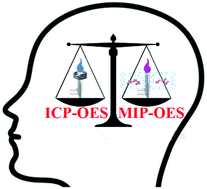Is MIP-OES a suitable alternative to ICP-OES for trace element analysis?†
Abstract
Microwave-induced plasma optical emission spectrometry (MIP-OES) has been attracting growing interest since the introduction of a commercial instrument based on a Hammer cavity and resonant iris system (4100 MP-AES, Agilent Technologies) in 2012. During the past few years, important modifications have been made to the instrument to improve its analytical performance, and new models have been launched (4200 and 4210 MP-AES). These improvements, along with other performance studies, allowed for the instrument's use in several applications, with adequate analytical results, which raises the question of whether MIP-OES has positioned itself to become an alternative to the traditional inductively coupled plasma optical emission spectrometry (ICP-OES). In the present review, we describe recent advances in MIP-OES instrumentation and compare the method's figures of merit, as well as its ability to deal with matrix effects, with those typically observed in ICP-OES. We also discuss recent studies and strategies developed to overcome general MIP-OES limitations. Instrument accessories, plasma diagnostics strategies, new calibration methods, and developments in sample preparation and sample introduction are some of the strategies used to improve MIP-OES sensitivity and accuracy. Therefore, the aims of the present work are to identify applications for which MIP-OES has become competitive with ICP-OES, as well as to describe recent developments that contributed to MIP-OES' acceptance as a cost-effective alternative for trace element analysis.

- This article is part of the themed collections: ENQA - 20th Brazilian Meeting on Analytical Chemistry and JAAS Review Articles 2022


 Please wait while we load your content...
Please wait while we load your content...